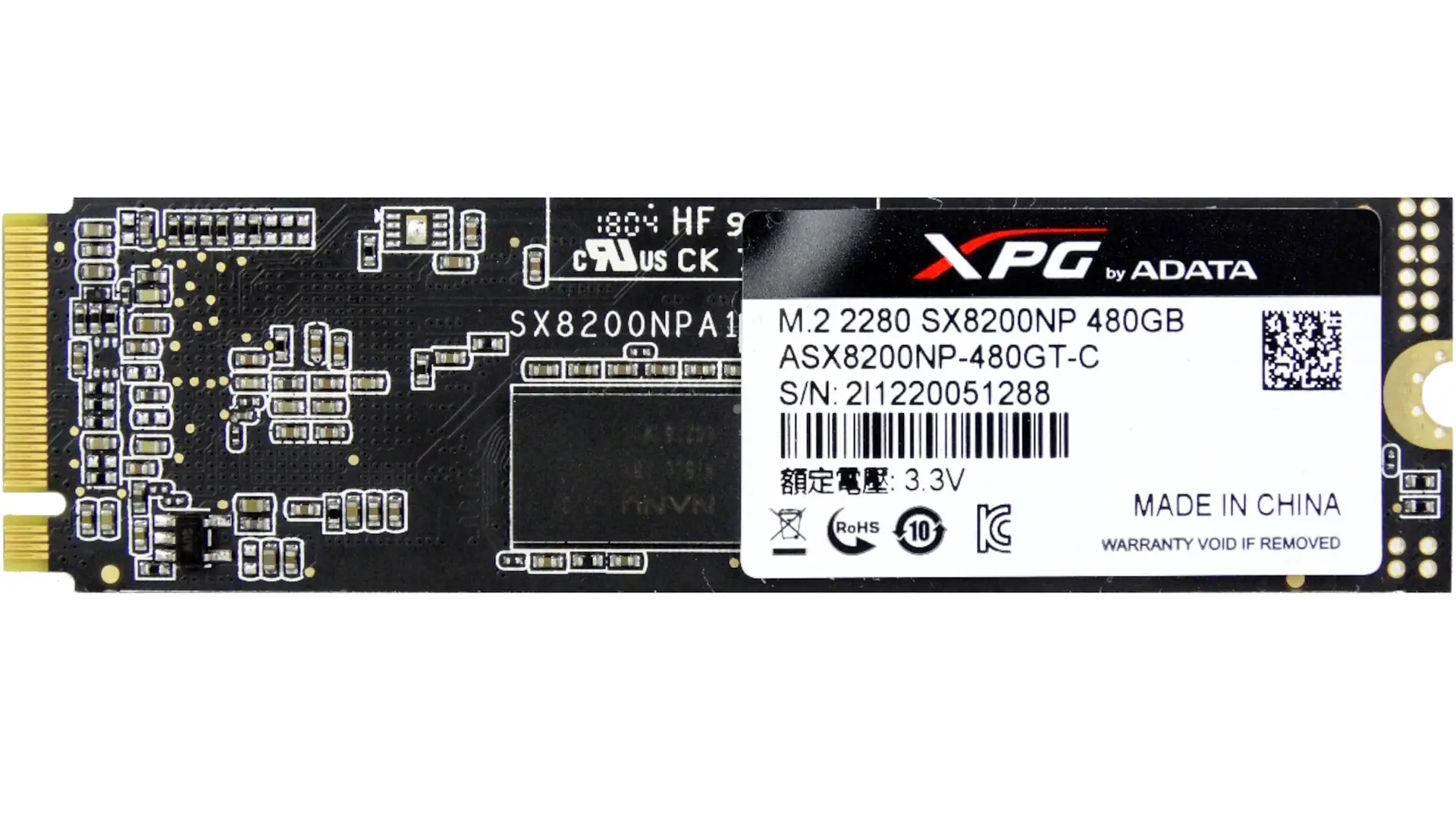In this article, I give you my ADATA XPG SX8200 Pro NVMe SSD review with specs included. Do you want a top-end performing NVMe solid-state drive but you don’t want to break the bank? Are you looking for something for a top-end premium build an i7 or a Ryzen 7, a premium machine that deserves a premium drive but you don’t like the prices of drives like the Samsung 970 Evo? I have a solution for you.
The ADATA SX8200NP 480GB M.2 2280 is an NVMe PCI-express 1.3 drive (Full name is ASX8200NP-480GT-C). It has a 64-layer 3D NAND, it has a DRAM cache, and an SLC cache, a five-year warranty. It essentially has all the latest and greatest technologies of drives and I will show you benchmarks below but as much as it doesn’t make a difference it is very, very similar in performance to the Samsung 970 Evo but for less money.
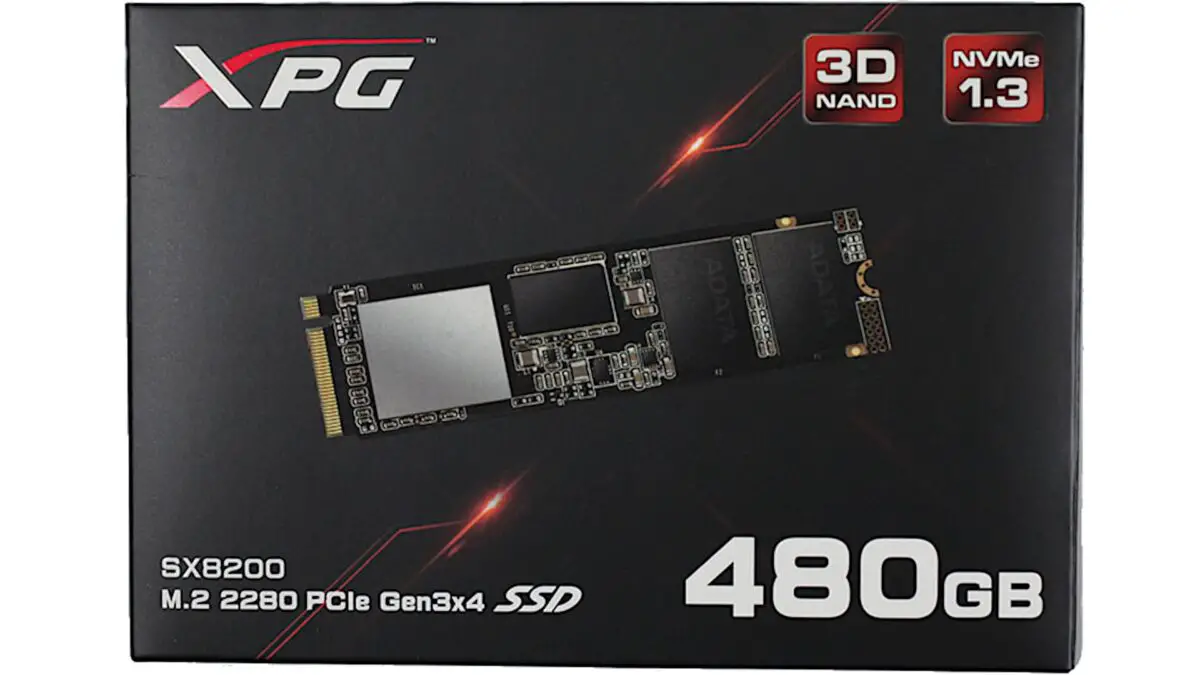
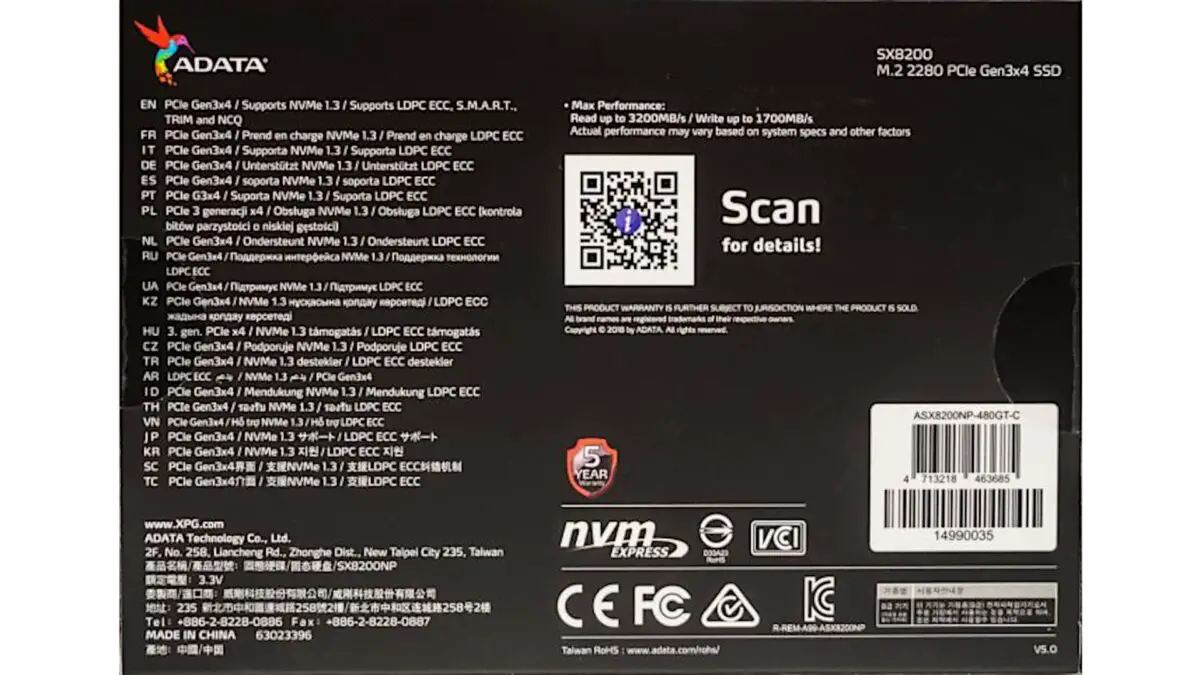
It is 40 dollars less expensive for the 500 GB size and $80 less expensive for the 1 terabyte. That’s money you can put your graphics card, more system RAM, and maybe get a larger Drive. That’s a deal!
Now, I’ve tested various NVMe drives in the past, and generally, my recommendation has always been if you’re going NVMe then get Samsung, they make the best. Now, Samsung’s still a great drive, I love them but, this is one of the first NVMe drives that I’ve tested that is both as fast as Samsung’s and a much lower price.
Because just being as fast at the same price doesn’t really bring anything to the table. It also does not sacrifice the warranty or any other features, it really is nice and I’m happy to show this to you in this article.
Now, let’s get to the benchmarks of these two drives and show you how good this SX 8200 really is. Up here for the test, we have the ADATA SX 8200 and we have the Samsung 870 Evo. Take a look at the first line, this is sequential transfer speed Q depth of 1 thread count of 1 this is what most people see on their desktop computers when they’re simply copying files.

The Samsung 970 Evo is about 10% faster in the sequential read speed, 2.2 gigabytes per second versus 2 gigabytes per second on ADATA but those are both exceptionally quick. It is also worth noting that drive companies love to advertise the speed but unless you’re just directly copying a file, and note these speeds require two separate drives to have them, if you’re copying a file or duplicating a file within the same Drive this isn’t typical user behavior.
Small random reads and writes are really what most people are gonna do so let’s bring that down to the second line random 4k read and random 4k write queue depth of 1 thread count of 1. Again, normal desktop behavior. Yes, the big numbers down below look pretty but this is the reality of it, this is what a normal single-user Windows 10 desktop environment is going to experience.

Now, the ADATA SX 8200 is in the 67 megabytes per second range and the Samsung 970 Evo is in the 71 megabytes per second range, which is 6% faster. It is faster a little bit on a benchmark, in the real world you’re never gonna notice the difference between these drives. They are very very close in terms of random read performance which is what you’re actually doing like opening your web browser, multitasking, switching, having Windows launched, closing, etc.
What you will notice, however, is the $40 price difference between the 500 GB size and the $80 price difference between the one terabyte size for 6 percent less random 1/k read performance and a 4k reading performance. You’re looking at a fairly substantial price difference, that’s not bad.

I would also like to note I gave Samsung the benefit of the doubt. The custom Samsung NVMe driver is installed which really only they make now. Anybody who buys a Samsung Drive can install that but I think that a lot of people who buy Samsung 970 Evos don’t download and install it. It is not automatic, you have to go to Samsung its website. Without that installed the performance is actually identical to the ADATA drive.
That’s just what’s missing on frankly eight it and everybody else’s NVMe drives. Samsung has the budget to write some custom software which gives them a small proof. It looks nice on charts, it lets them take the top of the leaderboard. Nobody goes, oh well Samsung’s the fastest, the Samsung is the fastest by six percent. This is a lot less money moving down to the bottom two lines.
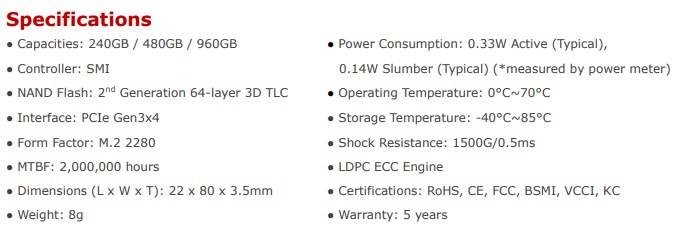
All I’ll really say here is, yes, the Samsung is a little bit faster but those are Q depth of 4 Q depth of 32, higher thread counts, and those are multi-user intense multitasking workloads. If you’re actually the kind of user who’s gonna be getting into heavy queue depth heavy thread-count, multi-user access, I wouldn’t get either one of these.
I would get an MLC drive such as the Samsung 970 Pro which will write full speed across the entire drive and has doubled the drive write endurance and so on and so forth.
If you’re running a server or a heavily used workstation the TLC drives wouldn’t be my first choice. But those drives cost a lot more money so this is more a single desktop standard user workload and between these drives, they’re very, very similar. A little bit of performance edge goes to Samsung but the price edge goes to ADATA.
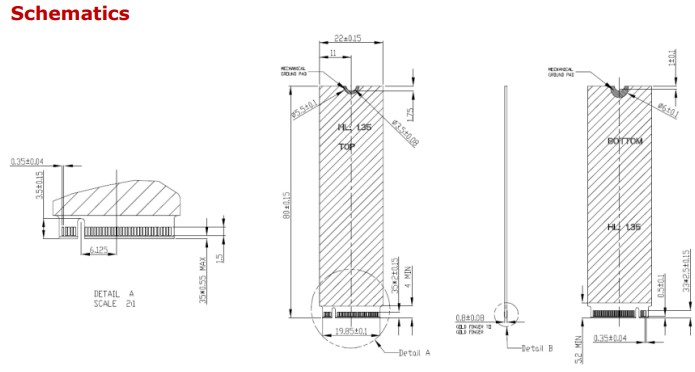
That brings us to the other two drives I’ve put on the desk and I’m bringing them here to bracket the ADATA drive in terms of price to performance to show you what you get by going higher and I’m gonna show you what you get by going a bit lower. now NVMe drives are nominally M.2 drives though the small drives you put on your motherboard this is an m2 Drive the Samsung 860 Evo is a SATA Drive a Serial ATA drive rather than an NVMe non-volatile memory Express Drive it’s not a PCI Express Drive it’s the same as the 2 and Finch version just in a more convenient form factor.
That is 132 dollars for the 500 GB drive, this is $139 there’s less than ten dollars difference between these drives. The two-and-a-half-inch version is a bit less but the M.2 version which matches this for ease of installation is less than ten dollars less expensive.

Let me show you the Samsung 860 Evo’s performance here next to the ADATA SX 8200 there’s no comparison in sequential performance. The ADATA is four times faster not four percent or 40 percent 400% faster it’s not even close.
Now, in terms of random read performance, the difference is not as dramatic but that’s true across all drives NVMe and SATA just because of the fact that single queue depth single thread count which is normal desktop workload doesn’t really let these drive shine as a multi-user environment does.
That being said, the Adata is more than 50 percent faster, not five percent, fifty percent faster than the Samsung 860 Evo for less than $10 more money, that’s a deal. Anytime you can get that kind of performance increase for such a marginal price increase that’s really where this just shines and blows away the competition.
Now, you can buy 500 GB SATA drives for less than this. A Western Digital Blue is less than this, it’s also not as fast I’m just using it to show that the flagship drives the Samsung if you want to buy a less expensive drive well that’s what we have the mush can try after here for I recently did a review on this drive. This is available for under $80 480 GB, the same size as this it is worth buying but it’s nowhere near as fast as this and it’s not as fast as the Samsung is but again it’s under $80.
This is what I would put into a Ryzen 5, an i5, a Ryzen 3, or an i3, or an upgrade for an older system where price to capacity is the most important thing to consider.
Now I’m going to put its performance numbers up here and you’ll notice that the 4k random read speed is less than half that of the ADA in it is only about 30 ish megabytes per second but again it’s under $80 so the price reflects that for a mid-range to low-end system this is overkill this is a perfectly fine driver.
Frankly, I think all the Samsung are overkill for a mid-range or lower-end system but if you are building an i7 or Rison 7 if you want performance you want super quick boot times if you want super-fast game loading times you want your multitasking and web browser and everything to just snap this is the deal.
A quick note on test and benchmark suite configuration crystal disk mark is what you saw used for the benchmark numbers Ryzen 7 2700 X on an X470 wrong strict Sassoon motherboard was the test bench all of these drives were configured as a secondary drive in a PCI Express x4 Lane slot on the board the drives were completely clean and bare all of these are brand new drives with no use behind them windows was not installed on them it’s installed on a separate drive on the machine.
And then finally 16 GB of RAM has been installed there not that that matters but I’ll mention it so this test is about as even and fair as I can possibly make it.
Now, it’s not necessarily real-world in the sense that those are synthetic numbers but it gives you a really good way and consistent way to compare the performance of different drives thus the reason I use it.
Here’s an extensive list of pros and cons for the ADATA XPG SX8200 Pro NVMe SSD:
Pros:
- Performance: Offers excellent read and write speeds, making it suitable for demanding tasks such as gaming, content creation, and data-intensive applications.
- NVMe Interface: Utilizes NVMe protocol for faster data transfer rates compared to traditional SATA SSDs, resulting in improved system responsiveness and reduced loading times.
- Storage Capacity Options: Available in various capacities ranging from 256GB to 2TB, catering to different storage needs and budgets.
- Reliability: Built with high-quality NAND flash memory and a durable design, ensuring reliability and longevity for long-term use.
- DRAM Cache: Features a DRAM cache buffer that enhances multitasking performance and maintains consistent data transfer speeds, especially during heavy workloads.
- Compact Form Factor: Utilizes the M.2 2280 form factor, allowing for easy installation in compatible desktops, laptops, and small form factor systems.
- Power Efficiency: Consumes less power compared to traditional hard disk drives (HDDs), resulting in improved energy efficiency and longer battery life for laptops.
- Compatibility: Compatible with various operating systems and platforms, including Windows, macOS, and Linux, offering flexibility for different user environments.
- Advanced Features: Supports features such as SLC caching, LDPC error correction, and wear leveling, enhancing performance, data integrity, and endurance over time.
- Value for Money: Provides a competitive price-to-performance ratio, offering high-speed storage solutions at an affordable price point compared to other NVMe SSDs on the market.
Cons:
- Heat Dissipation: May generate more heat compared to SATA SSDs, requiring adequate airflow or additional cooling solutions, especially under heavy workloads or in compact systems.
- Limited Warranty: Comes with a limited warranty period, typically ranging from 3 to 5 years, which may be shorter compared to some competing SSD models with longer warranty coverage.
- Endurance: While durable and reliable, the endurance rating (TBW – Total Bytes Written) may be lower compared to some high-end NVMe SSDs, particularly for heavy write-intensive workloads.
- Compatibility Issues: Some users may encounter compatibility issues with certain motherboards or systems due to differences in firmware, BIOS, or driver support, requiring firmware updates or driver installations for proper functionality.
- Driver Optimization: Depending on the operating system and hardware configuration, users may need to install specific drivers or firmware updates to unlock the full potential of the SSD and ensure optimal performance.
- Lack of Data Recovery Software: Unlike some premium SSDs that come with bundled data recovery software, the ADATA XPG SX8200 Pro may not include such utilities, requiring users to rely on third-party solutions for data recovery in case of accidental data loss or drive failure.
- Competitive Market: Faces competition from other NVMe SSD manufacturers offering similar performance and features, making it important for users to compare specifications, reviews, and prices before making a purchase decision.
Overall, the ADATA XPG SX8200 Pro NVMe SSD offers a compelling combination of performance, reliability, and value, making it a solid choice for users seeking high-speed storage solutions for their computing needs. However, potential buyers should consider their specific requirements, budget constraints, and compatibility considerations before making a final decision.
ADATA XPG SX8200 Pro NVMe SSD
-
Performance - 94%94%
-
Price - 93%93%
-
Value - 94%94%

